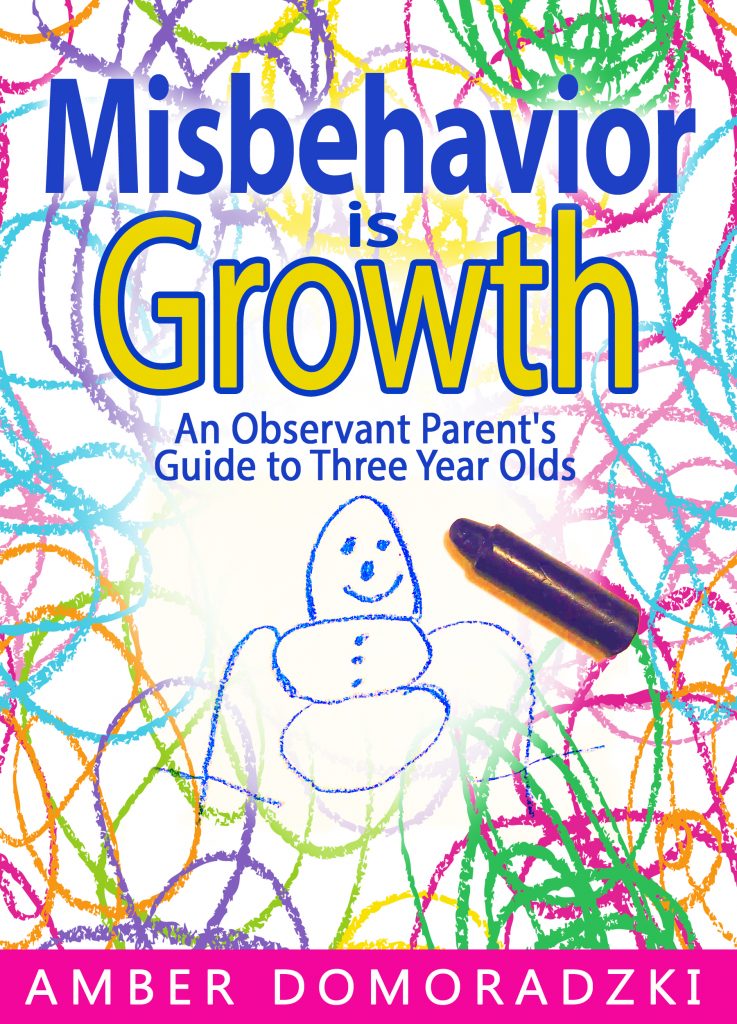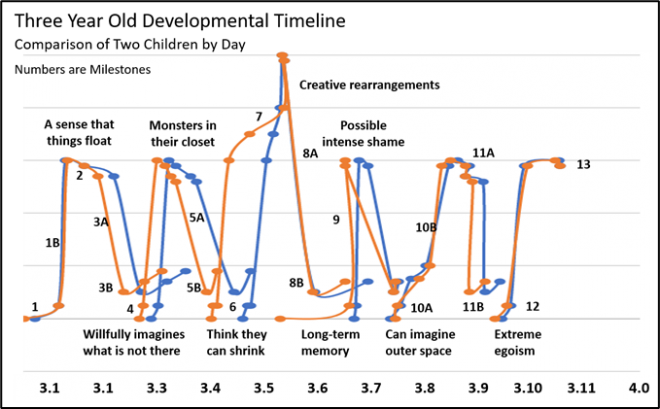I noticed something as I fought and fought with refining the child development milestones I document for age three. I was doing this in preparation for my next book, Misbehavior is Growth: Three Year Olds.
I noticed that children tended to go “up” into fantasy play to learn a new skill, then came back “down” to reality to apply it. But more than that, there seemed to be stages in it. Offhand, I could recite to you one or two of these “hills,” which I now call them. But there was definitely more than the one or two hills that I intuitively could recite. And they clearly inter-mixed with each other. What were the sub-stages to these hills? Because going up and down one seemed to have several steps.
After fighting with it for days, to the point my eyes were literally dried out, I finally got it. I had an aha moment when I realized a mistake I made. And after I recognized my mistake, the stages in each hill fell into place like shuffling a deck of cards.
This is it though this may be a bit cluttered:

As a summary, each hill is kicked off with a Shock Stage. There is some overly optimistic thinking that Mother Nature gives. An example is thinking they can shrink. This spurs development of a new skill, causing the child to gather things needed to learn their new skill. Then at the top of the hill, their overly optimistic thinking turns frightening. They originally thought they could shrink. They thus have a thwarted sense of depth perception. A frightening thing they might think is that oncoming cars can flatten them. This sends them back down the hill, as they want more control over reality. Going back down has several sub-steps, too.
Here is an expanded definition of each sub-stage:
Going Up the Hill:
Going up the hill has a few basic stages.
Shock Stage: Each hill is kicked off with a Shock Stage. This Shock Stage is their overly optimistic thinking about something. A great example is again thinking they can shrink. This drives them to learn about this new skill as they try do what their imagination just gifted them with.
Gathering and Sorting Stage: They gather what they need to learn the skill, either physically or mentally by noting more. They also process what they are learning, often by sorting things: this is this; that is that. In this processing, the nature of what they are learning about becomes crystal clear in their mind. See Mental Sorting at 3.0.
Playfully Creative Stage: They may also play around with the new skill, often in a totally random, delightful way. It is a calm, happy time. See Deliberate Planning at 3.1.
Going Back Down the Hill:
Then they are whooshed back down the hill, back to reality. Something seems to kick this off, too. There are several distinct stages going down the hill:
Frightened Stage: From what I can tell, to apply the new core skill set back to reality, something frightens the child. This thus makes them want more control over reality. This frightening thing is related to the initial Shock Stage. If they thought they could always predict the next event, they now seem to think that things float around too much. If they think they can shrink and get good (or bad) at depth perception, they think oncoming cars will flatten them. If they can willfully imagine imaginary things, they start to see monsters in their bed. All of these things are scary, and they want to stop them from happening. These frightening things, which bring realism to their initial over-optimism, send them back down the hill. They want—need—better control over their life and surroundings. An example is the monsters they see in their closet at Intentional Imaging.
Wild and Free: Almost immediately after their initial shock and confusion from being frightened, they become wild and free. They are confident and bold, as they try wild things out. Perhaps a sense of “do or die” from being frightened drives this? Either way, they are highly creative, but in much more bold, aggressive ways. Things get rearranged, you may get bossed around, papers are filled up with drawings, etc. They have wild fantasies about doing things, maybe magically moving rooms around or booming cars out of their way. They live in a happily delusional, invincible bubble. See Creative Rearrangements at 3.5.
Evaluative Stage: Next they are evaluative of their own decisions. They realize they want to get things right. They can become cautious, deliberate, hesitant, and responsible. They are most likely to be prone to shame, hard on themselves, or sensitive to rejection at this stage. See Personal Reflection at Milestone 8C.
Stuck Stage: Then they get too rigid and stuck in their new skill. This leads to problems, where they are indeed very fluid and confident in one skill, yet lacking in another. They can become overly rigid in applying their new skill, imprecise in applying it, hypocritical, and overly ambitious. But, don’t worry. Mother Nature will (if allowed) shock them out of that rigid thinking too, and likely soon. Child development is a constant equilibrium of overshooting one skill, coming back, overshooting again, etc.
Complexity Stage: Then, the last stage of any hill is a bit complex. In the Gathering and Sorting Stage of the next hill complexity is added to the current hill. As an example, if one hill (A) is they applied ideal behavior to themselves and the next hill (B) is a longer memory, the last stage of Hill A is they apply ideal behavior to themselves across a greater length of time. And Hill C will get applied to Hill B and Hill A, and so on and so on.
Baking Stage: So, there is one more stage. All of the previous stages act as a baking stage for the next hill. Skills acquired here set them up for whatever Shock Stage Mother Nature has in store next.
So here is an example of one hill in the very early 3s. This spans over Milestone 1 and the next several milestones

In this hill, they start to make one next mental guess. They know you are going to see the swans. So maybe you can feed them. Similarly, they abstract one level higher. All of this group of people aren’t just [so and so], they are “grandma.” Or these cars aren’t just cars, they are “race cars.” They sort things endlessly like this, either in their play or mentally, depending on their personality. This sorting itself, I argue, helps with data recollection. They notice more about the quirks of people around them or how race cars have a fast engine that makes them go fast. In doing this, they individuate. They apply some of these roles to themselves. They pretend to be their favorite character. This is Milestone 2 , “Deliberate Planning,” in my documentation for three year olds.
It was, so far as I have found anyway, always the case that they go both inwards and outwards. So while they are applying this new deliberate way to be to themselves, they are also applying it to the outwards reality. So Deliberate Planning happens at the same time as Deliberate Personality:

The frightening stage is easier to explain with this one. They start to have a sense that things magically float around. They think entire rooms can magically float to them. This scares them, as they sincerely think you won’t stop before you get to a Stop sign. They want control over reality. They start to apply their new skill. At first, it’s still imaginative. They pretend to be a soldier low crawling–so they can steal your food. This is their new personality and new planning acting as one. But then they get too stuck. They are too bossy. Rules are to be followed, blindly. But the next stages at the next hills, The Complexity Stage previously described, kicks them out of that thinking.
Personally, I think all of this should flip traditional education on its head. Traditional education assumes a child is dead inside. It assumes children have no natural interest in anything and have to be prodded, somehow, to get on the agenda. Maybe they brute force ask a child to memorize something, to “spur interest,” but in a silly, enticing way, such as singing a song. Maybe they ask a “mystery” question to draw interest. This “mystery question” is the same reason adults click on links that say “Surprising Reasons Wives Leave Their Husbands!” It’s click baity. I don’t think it’s necessary. They already HAVE interest in a LOT of stuff. When they are, get on that train. Unleash what is already in them.
And, yes, they go through all the steps then to learn something. They categorize and sort things. They do that, naturally. They learn the “basics” (the “grammar”) of something. I found a Gathering Stage, consistently, in my research. They go and get what it is they need to learn. We’re just constantly squashing this in them. We’re always asking them to behave and not throw. My argument is this is part of their natural development. Yes, it’s wild and belligerent. It has to be. How else does anything get shook up or actually learned? We need to “throw spaghetti on the wall” sometimes to truly learn.
Anyway. I plotted these hills over age of three. Here is the chart:

There are two children plotted here. Each node is an exact day in development when something developmentally significant happened. I noted them and categorized the behaviors based on hill and hill level to put them into this chart. The numbers listed are the milestones for age three.
Yes, there is variability among the two children. But a pattern forms. Each hill above is as described previously. It kicks off with over optimism and comes back down when a child is frightened by something. Going up, they are learning. Going down, they are applying. And the uptick at the end is when new skills from the next hill get directly applied to the previous one.
I am excited for this because I think it allows you to recognize child development easier. Instead of looking at a timeline, you can look for behavior. When your child thinks rooms can float, something significant is happening. When they see monsters in their closet, something significant is happening. And you can predict next events, too. After being frightened, they are likely to come back to reality. They are going to become wild and free. And given they are frightened and we know better why, we might know that what they really need is to be anchored. They don’t need to be told the monsters aren’t real. They are soon to apply new skills to reality, anyway. Let’s aid them in this. Let’s ground them and bring them back to “earth.”
I’m super excited for all this. It opens up so much. All researchers have to do is add more children to the chart above to get a better idea of variability in child development. And if my “hills” hold up, I think I have uncovered something pretty significant. It can dramatically change the way we parent and educate.
Please. Share this with others. I hope the visuals and explanations helps. I discuss all this much further in my next book Misbehavior is Growth: An Observant Parent’s Guide to Three Year Olds.


Send your friends to www.theobservantmom.com

2 thoughts on “The Hills of Child Development Age Three”